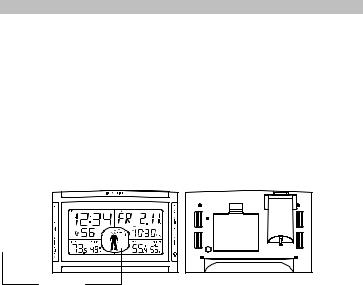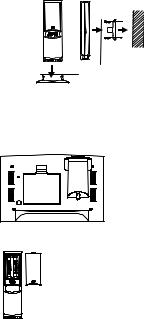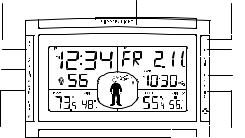La Crosse Technology WS-9520U, WS-9520U User Manual

WEATHER PROJECTION STATION
Instruction Manual
INTRODUCTION:
Congratulations on purchasing this state-of-the-art weather projection station as an example of innovative design and quality piece of engineering. Providing radio controlled time, date, calendar, moon phase, indoor and outdoor temperature, indoor and outdoor relative humidity, this unit will never keep you guessing on current and future weather conditions. Operation of this product is simple and straightforward. By reading this operating manual, the user will receive a better understanding of the weather projection station together with the optimum benefit of all its features.
FEATURES:
The Weather Projection Station
LCD |
|
|
Battery |
|||
Display |
|
|
compartment Projector |
|||
|
SNOOZE key |
|||||
|
|
|
|
|
|
|
|
|
|
|
|
|
|
|
|
|
|
|
|
|
Function
keys
•WWVB Radio-controlled time with manual setting option
•Time reception ON/OFF (user selectable)
•12/24-hour time display
•DST ON/OFF (daylight saving time)
•Time zone option ±12 hours
•Month, date, weekday calendar display
•Alarm setting with snooze function
•Automatic daylight saving time updating
•Weather forecasting with 24 combinations of weather icons and “weather boy” images
•Weather tendency indicator
•Temperature display with MIN/MAX records and time of reception
•Indoor and outdoor temperature display in ºF/ºC
•Humidity data with MIN/MAX records
•Indoor and outdoor humidity display as RH%
1

•Can receive up to 3 remote temperature/humidity sensors
•Time projection display (hour and minute)
•Outdoor temperature projection display (degrees ºF or ºC)
•Alternate projection display mode selectable
•Projection with adjustable brightness and projection orientation possible
•LCD contrast selectable
•E.L. back light
•Low battery indicator
•Table standing
•AC/DC power adapter included
The Remote Temperature/Humidity Sensor
Table stand/wall mount bracket
•Remote transmission of outdoor temperature and humidity to weather projection station by 433 MHz
•Rain proof casing
•Wall mounting case
•LCD display of temperature and humidity readings
TO INSTALL AND REPLACE BATTERIES IN THE WEATHER PROJECTION STATION
The weather projection station uses 3 AA batteries. To install and replace the batteries, please follow the steps below:
1.Push down on the top center of the battery cover and pull away from the unit to remove the cover.
2.Insert batteries observing the correct polarity (see marking).
3.Replace compartment cover.
TO INSTALL AND REPLACE BATTERIES IN THE REMOTE TEMPERATURE/HUMIDITY SENSOR
The remote temperature/humidity sensor uses 2 AA batteries. To install and replace the batteries, please follow the steps below:
1.Remove the battery cover.
2.Insert the batteries, observing the correct polarity (see marking).
3.Replace the battery cover on the unit.
Note: In the event of changing batteries in any of the units, all units need to be reset by following the set-up procedures. This is due to a random security code assigned by the remote temperature/humidity sensor at start-up. This code must be received and stored by
the weather projection station in the first 3 minutes of power being supplied to the remote temperature/humidity sensor.
2

BATTERY CHANGE:
It is recommended to replace the batteries in all units on an annual basis to ensure optimum accuracy of these units.
Please participate in the preservation of the environment. Return used batteries to an authorized depot.
SETTING UP
The weather projection station can be either batteries-operated or powered by the provided AC adapter.
BATTERY INSTALLATION:
1.First, insert the batteries into the weather projection station (see “To install and replace batteries in the weather projection station”). Once the batteries are in place, all segments of the LCD will light up briefly and a short signal tone will sound. Then the ALM1 6:00, the indoor temperature and humidity, the time as 12:00, the date as WE 1.1. and the weather icons will be displayed. If the indoor temperature and indoor humidity are not displayed after 15 seconds, remove the batteries and wait for at least 3 minutes before reinserting them. Once the indoor data is displayed proceed to step 2.
2.Within 4 minutes of activating the weather projection station, place the batteries into the remote temperature/humidity sensor (see “To install and replace batteries in the remote temperature/humidity sensor“).
3.After inserting the batteries into the remote temperature/humidity sensor, the weather projection station will start receiving data from the remote temperature/humidity sensor. The outdoor temperature and humidity should then be displayed on the weather projection station. If this does not happen after 3 minutes, the batteries will need to be removed from both units and reset from step 1.
4.The weather projection station can receive up to 3 remote temperature/humidity sensors. If you have purchased additional remote temperature/humidity sensors, repeat from step 3 for all extra remote temperature/humidity sensors. However, ensure that you leave 10 seconds in between the reception of the last remote temperature/ humidity sensor and the set-up of the following remote temperature/ humidity sensor. The weather projection station will number the remote temperature/humidity sensors in the order of set-up, i.e. the first remote temperature/humidity sensor will have the temperature/humidity displayed with the number 1 against it and so on.
5.With less than 3 remote temperature/humidity sensor received, the weather projection station will try to pick up the remaining one in approximately another 3 minutes. If 3 remote temperature/humidity sensors are received, the weather projection station will stop further reception.
6.Once the outdoor temperature and the humidity have been received and displayed on the weather projection station, the WWVB time code reception is automatically started. This takes typically between 6-8 minutes in good conditions.
7.If after 10 minutes, the WWVB time has not been received, use the SET key to manually enter a time initially. The clock will automatically attempt to receive the WWVB time from 12:00 to 6:00 a.m. for a successful reception. When WWVB reception signal is successful, the received time will override the manually set time. The date is also updated with the received time. The next reception attempt will occur on the following day. (Please refer to notes on “About WWVB Radio controlled Time” and
“Manual Time Setting”).
Your weather projection station is now operational!
Note:
If the batteries are used as the main power source:
1.Projected image brightness, alarm volume and back-light strength will be weaker when batteries are low
2.Battery life time will be much less than 1 year; depending on the frequency of projection and alarm.
3

TO USE THE WEATHER PROJECTION STATION POWER ADAPTER
The unit comes with an AC adapter for using the projector for an extended period of time, such as throughout the night.
To connect the AC adapter:
Important!
Make sure that your household voltage is 120V! Otherwise it can result in damaging your weather projection station.
1.Connect the AC adapter to a wall socket. Plug the adapter into the jack on the back of the weather projection station. All segments of the LCD will light up briefly and a short signal tone will sound. Then the ALM 1 6:00, the indoor temperature and humidity, the time as 12:00, the date as WE 1.1and the weather icons will be displayed. If the indoor temperature and indoor humidity are not displayed after 15 seconds, remove the batteries and wait for at least 3 minutes before reinserting them.
2.Within 4 minutes of activating the weather projection station, place the batteries into the remote temperature/humidity sensor (see “To install and replace batteries in the remote temperature/humidity sensor“).
3.After inserting the batteries into the remote temperature/humidity sensor, the weather projection station will start receiving data from the remote temperature/humidity sensor. The outdoor temperature and humidity should then be displayed on the weather projection station. If this does not happen after 3 minutes, the batteries will need to be removed from both units and reset from step 1.
4.The weather projection station can receive up to 3 remote temperature/humidity sensors. If you have purchased additional remote temperature/humidity sensors, repeat from step 3 for all extra remote temperature/humidity sensors. However, ensure that you leave 10 seconds in between the reception of the last remote temperature/humidity sensor and the set-up of the following remote temperature/humidity sensor. The weather projection station will number the remote temperature/humidity sensors in the order of set-up, i.e. the first remote temperature/humidity sensor will have the temperature/humidity displayed with the number 1 against it and so on.
5.With less than 3 remote temperature/humidity sensors received, the weather projection station will try to pick up the remaining one in approximately another 3 minutes. If 3 remote temperature/humidity sensors are received, the weather projection station will stop further reception.
6.Once the outdoor temperature and the humidity have been received and displayed on the weather projection station, the WWVB time code reception is automatically started. This takes typically between 6-8 minutes in good conditions.
7.If after 10 minutes, the WWVB time has not been received, use the SET key to manually enter a time initially. The clock will automatically attempt to receive the WWVB time from 12:00 to 6:00 a.m. for a successful reception. When WWVB reception signal is successful, the received time will override the manually set time. The date is also updated with the received time. The next reception attempt will occur on the following day. (Please refer to notes on “About WWVB Radio controlled Time” and
“Manual Time Setting”).
Your weather projection station is now operational!
4

Note:
If the weather projection station is powered through the AC adapter, the projection will be constantly ON.
If the weather projection station is battery operated the projection will turn ON only when the SNOOZE key is pressed. Once the SNOOZE key is released, the projection and E.L. backlight will stay on for approximately 10 seconds.
USING BOTH BATTERIES AND THE POWER ADAPTOR
When using both the AC adaptor and batteries the main power source of the weather projection station will switch to AC power. The batteries will then act as a backup power source in the case of power failure.
RESETTING
The weather projection station and the remote temperature/humidity sensor need to be reset when one of the following conditions occur:
•Unsuccessful 433MHz signal reception.
•Malfunction of the units.
•Batteries need replacement.
For resetting, remove all batteries from the units and unplug the AC adapter from the power source. Wait at least for 3 minutes before powering up the weather projection station again. Proceed from step 1 in
“Setting Up”, “Battery Installation” or “How to use the Projection Station Power Adaptor”.
HOW TO USE THE PROJECTOR
The projector projects the current time and the current outdoor temperature onto the ceiling, only within a darkened room. The projection image can also be adjusted in 4 upright positions, each with a rotation of
90º by using the  key.
key.
TO PROJECT THE TIME OR TEMPERATURE ONTO A FLAT SURFACE:
The projector will only project the current time, outdoor temperature or alternate between time/outdoor temperature only.
1.Point the projection lens to the appropriate direction (ideal distance of the projection is 6 feet/2 meters).
2.Press the DISPLAY key to select the desired mode for the projection. There are 3 display modes: M0 – projecting the current time only.
M1 – projecting the current outdoor temperature only.
M2 – projecting by switching the display of the current time and the current outdoor temperature for every 5 seconds.
3.Adjust the projection image in an upright position with the  key.
key.
Note:
If more than one remote temperature/humidity sensor is used, only the temperature from remote temperature/humidity sensor 1 will be projected.
ABOUT WWVB RADIO CONTROLLED TIME
The NIST (National Institute of Standards and Technology—Time and Frequency Division) WWVB radio station is located in Ft. Collins, Colorado, and transmits the exact time signal continuously throughout the United States at 60 kHz. The signal can be received up to 2,000 miles away through the internal antenna in the weather projection station. However, due to the nature of the Earth’s Ionosphere, reception is very limited during daylight hours. The weather projection station will search for a signal every night when reception is best.
5

The WWVB radio station receives the time data from the NIST Atomic clock in Boulder, Colorado. A team of atomic physicists is continually measuring every second, of every day, to an accuracy of ten billionths of a second per day. These physicists have created an international standard, measuring a second as 9,192,631,770 vibrations of a Cesium-133 atom in a vacuum. For more detail, visit http://www.boulder.nist.gov/timefreq.htm. To listen to the NIST time, call (303)499-7111. This number will connect you to an automated time, announced at the top of the minute in “Coordinated Universal Time”, which is also known as Greenwich Mean Time (GMT). This time does not follow Daylight Saving Time changes. After the top of the minute, a tone will sound for every second. It is possible that your weather projection station may not be exactly on the second due to the variance in the quartz. However, the clock will adjust the quartz timing over the course of several days to be very accurate; under 0.10 seconds per day.
FUNCTION KEYS:
Weather Projection Station:
The weather projection station has 9 easy to use function keys; 4 on the left, 4 on the right, and 1 on the top of the unit:
SET key |
SNOOZE key |
CH/+ key |
|
||
HOUR/IN |
|
MIN/OUT |
key |
|
key |
ALARM 1 |
|
ALARM 2 |
key |
|
|
|
key |
|
|
|
|
DISPLAY key |
|
DIRECTION key |
SET key
•Enter manual setting modes: LCD contrast, time zone, DST ON/OFF, Time reception ON/OFF, 12/24 hour display, manual time setting, calendar, snooze function, temperature °F or °C, and weather icon sensitivity setting
•Stop the alarm during alarm ringing
•Stop snooze mode
•Back-light on
CH/+ key
•Increase value in all setting modes
•Stop the alarm during alarm ringing
•Toggle between the outdoor transmitter 1, 2 and 3 (if more than 1 transmitter is used)
•Stop snooze mode
•Back-light on
6
